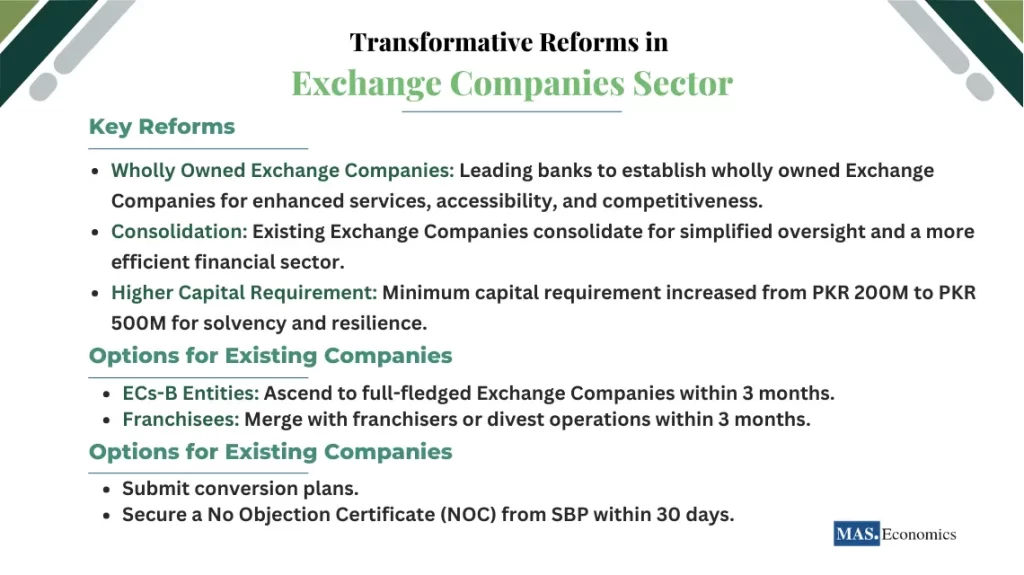Welcome to MASEconomics, your trusted source for navigating the dynamic world of economics. In this article, we dive deep into the recent transformative reforms unveiled by the State Bank of Pakistan (SBP) within the Exchange Companies sector. These reforms have a clear mission: to elevate transparency, enhance competitiveness, and streamline overall efficiency. Furthermore, they are set to fortify governance, internal controls, and a culture of compliance.

Key Reforms in the Exchange Companies Sector
Introduction of Wholly Owned Exchange Companies
Leading banks, already deeply entrenched in foreign exchange operations, will establish wholly owned Exchange Companies. This strategic move is poised to set off a ripple effect in the foreign exchange market. Customers can anticipate an elevated level of service quality, improved accessibility, and more competitive rates. This shift is a catalyst for Exchange Companies to enhance their offerings and customer support, ensuring they remain formidable in this evolving landscape.
Consolidation of Existing Exchange Companies
Existing Exchange Companies, along with their franchisees, will unite under a single category. This consolidation simplifies regulatory oversight, alleviating complexity for businesses and consumers alike. A clearly defined mandate will empower Exchange Companies to harmonize their operations with regulatory prerequisites. The outcome: a financial sector that’s more efficient and accountable.
Minimum Capital Requirement Increase
The bar has been raised substantially, with the minimum capital requirement for Exchange Companies catapulted from PKR 200 million to PKR 500 million. This strategic move is designed to reinforce the solvency of Exchange Companies and equip them to construct robust infrastructure and systems. A higher capital buffer equips them to weather economic turbulence, protecting the interests of customers and preserving market integrity. This change aligns with global best practices, bolstering the sector’s resilience.
Options for Existing Exchange Companies
For ECs-B (Exchange Companies of Category ‘B’):
ECs-B entities can ascend to full-fledged Exchange Companies, provided they swiftly meet all regulatory criteria within a concise three-month window. This action is imperative to retain their licenses.
For Franchisees of Exchange Companies
Franchisees can opt to either merge with their respective franchiser companies or divest their operations to the concerned franchisers. The transition should unfold within three months, following the fulfillment of all regulatory obligations.
Compliance and Application Process
ECs-B and Franchisees of Exchange Companies have a pivotal task at hand: submit comprehensive conversion plans and secure a No Objection Certificate (NOC) from the SBP within a 30-day timeframe. The NOC application should encompass detailed conversion/merger strategies, proposed shareholding structures, shareholder and director information, and the requisite board resolutions.
The Driving Force Behind These Reforms
These transformative reforms are underpinned by a clear-cut objective: to deliver superior services to the public. How? By turbocharging transparency and igniting competition within the Exchange Companies’ sector. Additionally, they serve as a cornerstone for buttressing governance, fine-tuning internal controls, and nurturing a culture steeped in compliance. The aim? Ensuring the sector’s enduring sustainability.
Conclusion
The State Bank of Pakistan’s sweeping reforms within the Exchange Companies sector represent a pivotal stride towards modernizing and optimizing foreign exchange services. By cultivating competition, amplifying transparency, and embedding robust governance, these reforms are set to redefine the landscape. It’s now incumbent upon Exchange Companies to expediently embrace the new regulatory landscape and harness the opportunities it presents.
Stay informed, stay ahead, and keep learning with MASEconomics!







.png?w=100&resize=100,70&ssl=1)








